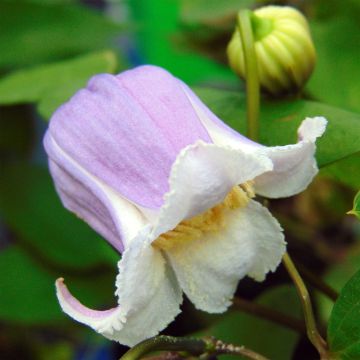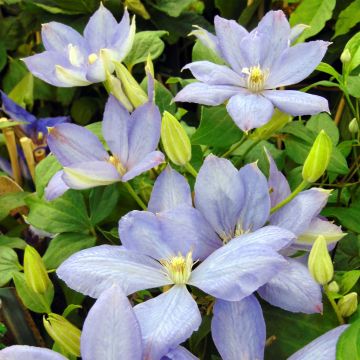

Clematis texensis Prince William


Clematis texensis Prince William
Clematis texensis Prince William
Clematis texensis Prince William
Scarlet Leather Flower, Texas Clematis
The clematis arrived tangled in the rose bush. All the branches were broken. I tried to plant it, but it died within a few days.
Yves , 30/05/2024
Special offer!
Receive a €20 voucher for any order over €90 (excluding delivery costs, credit notes, and plastic-free options)!
1- Add your favorite plants to your cart.
2- Once you have reached €90, confirm your order (you can even choose the delivery date!).
3- As soon as your order is shipped, you will receive an email containing your voucher code, valid for 3 months (90 days).
Your voucher is unique and can only be used once, for any order with a minimum value of €20, excluding delivery costs.
Can be combined with other current offers, non-divisible and non-refundable.
Home or relay delivery (depending on size and destination)
Schedule delivery date,
and select date in basket
This plant carries a 6 months recovery warranty
More information
We guarantee the quality of our plants for a full growing cycle, and will replace at our expense any plant that fails to recover under normal climatic and planting conditions.
Would this plant suit my garden?
Set up your Plantfit profile →
Description
The Clematis texensis 'Prince William', recently selected in the Netherlands, stands out from other clematis in its group with its remarkable flower colour and vigour. Its bell-shaped corollas, characteristic of texensis, are surrounded by purple-violet sepals bordered with mauve, the inside of the flower being mauve with a central violet zone, a bright and vibrant colour that pairs perfectly with late-season flowers. This robust variety blooms throughout the summer. Clematis texensis is a reliable, undemanding plant that is not very susceptible to wilt disease. Plant them in ordinary but well-drained and deep soil, in a very sunny location in the North of Europe and in partial shade in the South.
The genus Clematis belongs to the family Ranunculaceae. 'Prince William' is a Dutch horticultural variety introduced to the market in 2017. This variety is derived from Clematis texensis, a botanical species endemic to the southeast of the Edwards Plateau in Texas. It belongs to clematis that bloom in summer on barely lignified shoots of the current year, which then disintegrate in winter. It is a woody-based, creeping and climbing perennial plant that will reach a height of 3m (10ft), with a spread of 1m².
This clematis bears texensis-type flowers, of a beautiful size, reaching 4 to 6cm (2in) in length and 4 to 5cm (2in) in diameter. They are produced in successive waves and abundantly from June to September. The bisexual flowers are solitary or grouped in cymes. They emerge as small purple buds, only slightly longer than the tip of the index finger. Then they elongate and open into campanulate bell-shaped flowers, with a fairly fleshy texture. They flare out and open, resembling a star, with 4 mauve petals with a violet median and lighter margins. The exterior of the bell is a very dark purple colour. The flowering is followed by decorative feathery fruits, greyish with a silvery touch. The leaves are small, round, heart-shaped and rather light green. This clematis clings to the support or host plant through petioles transformed into tendrils.
Plant your clematis alongside your climbing roses or vines, as well as your jasmines, to extend the flowering of your walls and pergolas until the end of summer. This is a diverse genus, with flowers in all colours, shapes, and sizes. Take advantage of their easy cultivation to give your garden a romantic and bohemian touch. Clematis texensis can crawl freely in your borders and on low shrubs, they do not require pruning. Their fresh and lively bell-shaped flowers complement the most beautiful September blooms: the stars of asters, the blue of caryopteris, or the pink of heather (Erica multiflora). 'Prince William', due to its slightly larger growth, will work wonders in a free hedge or small tree.
Report an error about the product description
Clematis texensis Prince William in pictures




Plant habit
Flowering
Foliage
Botanical data
Clematis
texensis
Prince William
Ranunculaceae
Scarlet Leather Flower, Texas Clematis
Cultivar or hybrid
Other Clematis Texensis
View all →Planting and care
Plant the 'Prince William' clematis preferably in the sun, in fertile, humus-rich, well-drained soil, shading the roots and base of the stem (with a flat tile, for example). Herbaceous species prefer full sun and wilt in overly wet soil. Install your plant by covering the root ball with 3 cm (1in) of soil, in soil worked to a depth of 20 cm (8in), enriched with good compost. During the first few weeks, water regularly but be careful of stagnant water, as it can cause collar rot. Cover the base of climbing clematis with a small mound of soil, reducing the risk of wilting while promoting vigorous shoots from the stump. After planting, prune the stems of deciduous climbing clematis to around 30 cm (12in) from the base above a good pair of buds. Mulch in February with garden compost or well-rotted manure, avoiding direct contact with the stems. Train the stems, without squeezing them, until the plant can grip onto supports by itself. Clematis also like to grow freely on neighboring plants. Voles and grey worms can attack clematis and devour the stems. Aphids and greenhouse whiteflies are also potential pests.
Planting period
Intended location
Care
-
, onOrder confirmed
Reply from on Promesse de fleurs
Similar products
Haven't found what you were looking for?
Hardiness is the lowest winter temperature a plant can endure without suffering serious damage or even dying. However, hardiness is affected by location (a sheltered area, such as a patio), protection (winter cover) and soil type (hardiness is improved by well-drained soil).

Photo Sharing Terms & Conditions
In order to encourage gardeners to interact and share their experiences, Promesse de fleurs offers various media enabling content to be uploaded onto its Site - in particular via the ‘Photo sharing’ module.
The User agrees to refrain from:
- Posting any content that is illegal, prejudicial, insulting, racist, inciteful to hatred, revisionist, contrary to public decency, that infringes on privacy or on the privacy rights of third parties, in particular the publicity rights of persons and goods, intellectual property rights, or the right to privacy.
- Submitting content on behalf of a third party;
- Impersonate the identity of a third party and/or publish any personal information about a third party;
In general, the User undertakes to refrain from any unethical behaviour.
All Content (in particular text, comments, files, images, photos, videos, creative works, etc.), which may be subject to property or intellectual property rights, image or other private rights, shall remain the property of the User, subject to the limited rights granted by the terms of the licence granted by Promesse de fleurs as stated below. Users are at liberty to publish or not to publish such Content on the Site, notably via the ‘Photo Sharing’ facility, and accept that this Content shall be made public and freely accessible, notably on the Internet.
Users further acknowledge, undertake to have ,and guarantee that they hold all necessary rights and permissions to publish such material on the Site, in particular with regard to the legislation in force pertaining to any privacy, property, intellectual property, image, or contractual rights, or rights of any other nature. By publishing such Content on the Site, Users acknowledge accepting full liability as publishers of the Content within the meaning of the law, and grant Promesse de fleurs, free of charge, an inclusive, worldwide licence for the said Content for the entire duration of its publication, including all reproduction, representation, up/downloading, displaying, performing, transmission, and storage rights.
Users also grant permission for their name to be linked to the Content and accept that this link may not always be made available.
By engaging in posting material, Users consent to their Content becoming automatically accessible on the Internet, in particular on other sites and/or blogs and/or web pages of the Promesse de fleurs site, including in particular social pages and the Promesse de fleurs catalogue.
Users may secure the removal of entrusted content free of charge by issuing a simple request via our contact form.
The flowering period indicated on our website applies to countries and regions located in USDA zone 8 (France, the United Kingdom, Ireland, the Netherlands, etc.)
It will vary according to where you live:
- In zones 9 to 10 (Italy, Spain, Greece, etc.), flowering will occur about 2 to 4 weeks earlier.
- In zones 6 to 7 (Germany, Poland, Slovenia, and lower mountainous regions), flowering will be delayed by 2 to 3 weeks.
- In zone 5 (Central Europe, Scandinavia), blooming will be delayed by 3 to 5 weeks.
In temperate climates, pruning of spring-flowering shrubs (forsythia, spireas, etc.) should be done just after flowering.
Pruning of summer-flowering shrubs (Indian Lilac, Perovskia, etc.) can be done in winter or spring.
In cold regions as well as with frost-sensitive plants, avoid pruning too early when severe frosts may still occur.
The planting period indicated on our website applies to countries and regions located in USDA zone 8 (France, United Kingdom, Ireland, Netherlands).
It will vary according to where you live:
- In Mediterranean zones (Marseille, Madrid, Milan, etc.), autumn and winter are the best planting periods.
- In continental zones (Strasbourg, Munich, Vienna, etc.), delay planting by 2 to 3 weeks in spring and bring it forward by 2 to 4 weeks in autumn.
- In mountainous regions (the Alps, Pyrenees, Carpathians, etc.), it is best to plant in late spring (May-June) or late summer (August-September).
The harvesting period indicated on our website applies to countries and regions in USDA zone 8 (France, England, Ireland, the Netherlands).
In colder areas (Scandinavia, Poland, Austria...) fruit and vegetable harvests are likely to be delayed by 3-4 weeks.
In warmer areas (Italy, Spain, Greece, etc.), harvesting will probably take place earlier, depending on weather conditions.
The sowing periods indicated on our website apply to countries and regions within USDA Zone 8 (France, UK, Ireland, Netherlands).
In colder areas (Scandinavia, Poland, Austria...), delay any outdoor sowing by 3-4 weeks, or sow under glass.
In warmer climes (Italy, Spain, Greece, etc.), bring outdoor sowing forward by a few weeks.
















































